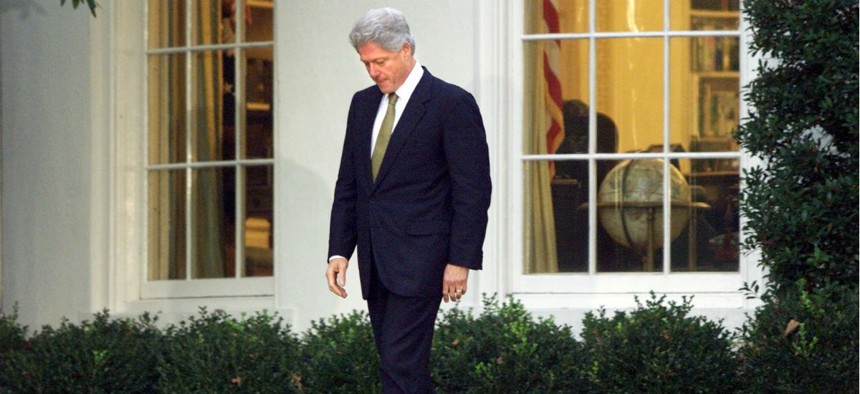
J. Scott Applewhite/AP file photo
What Hillary Clinton Could Learn From Her Husband's 1997 Budget Deal
Bill Clinton's tactics could help her advance her agenda if she wins the White House.
LAS VEGAS—Hillary Clinton’s rejection of cuts to Social Security and Medicare ranks high on the list of issues on which she’s moved to Bill Clinton’s left. But learning from her husband’s willingness to challenge Democrats on entitlement reform may be the key to advancing her own agenda if she wins the White House.
The lesson is embedded in the 1997 budget deal that Bill Clinton reached with a GOP Congress—an agreement that created the Children’s Health Insurance Program that Hillary Clinton often cites to show she will work across party lines. In that deal, Bill Clinton linked new spending on kids not to additional taxes, but to savings in entitlements for seniors. With that maneuver, Bill Clinton subtly shifted the debate away from increasing or shrinking spending toward recalibrating the way the budget balanced the needs of contrasting generations. A similar reframing may offer Hillary Clinton her best chance to avoid stalemate if, as it appears now, Republicans retain their House majority even if Clinton takes the White House and Democrats recapture the Senate.
The S-CHIP program, which provided health insurance to children in working-poor families, tracks the central thrust in Hillary Clinton’s domestic agenda. In the campaign, Clinton has proposed to invest in kids at all stages of their development: from grants to states to create universal access to pre-school; to expanded tax benefits for families (especially very low-income ones) with children; new subsidies to help parents afford child-care; and, as the capstone, free tuition at public colleges and universities, eventually for all families earning less than $125,000 annually. It’s a comprehensive, integrated plan for equipping more of America’s increasingly diverse future workforce with the skills to reach the middle class.
It’s also a plan very easy for congressional Republicans to oppose. Clinton pays for her ambitious investments with an array of new taxes, from a surtax on multimillionaires to limits on deductions for big earners. Maybe Clinton will win so big that Republicans will fear stonewalling her. More likely, House and Senate Republicans will feel entirely comfortable rejecting any new spending that requires new taxes.
Here is where the 1997 agreement could provide an alternative model. In that deal, Bill Clinton funded the S-CHIP program without new taxes by embedding it in an overall budget plan that meaningfully slowed the growth Medicare spending. His agreement with congressional Republicans didn’t raise taxes or enlarge the deficit; in fact, it pointed Washington toward the last balanced budgets it has achieved. But it did provide an overdue effort to generationally rebalance federal spending from seniors to kids by effectively funding S-CHIP mostly through cuts in payments to Medicare providers.
If anything, the need for generational balance in the federal budget has only grown since then. Washington spends over $6 per capita on seniors for every $1 it spends on kids, according to the Urban Institute’s latest Kids’ Share report. Even including state and local expenditures, which captures most education spending, governments at all levels still spend over twice as much on each senior as each child.
Looking forward, as the baby boom cascades into retirement, spending on retirees will increasingly squeeze other priorities. Total federal spending is expected to increase over the next decade by $1.5 trillion. But as the Urban Institute calculated, spending on the adult portions of Social Security, Medicare, and Medicaid will consume nearly three-fifths of that torrent, with interest on federal debt claiming much of the rest. Programs for children, it reports, will receive “just 2 cents of every dollar of the projected increase.”
That’s myopic not only for kids, but seniors. America’s rising generations are by far the most diverse in U.S. history: Kids of color already represent more than half of the nation’s public school students and will comprise a majority of the under-19 population by around 2020. Those are the country’s future consumers, workers, and critically, taxpayers.
Yet today, too many of these young people are not positioned to succeed. Roughly one-third of both African American and Hispanic kids live in poverty and about three-fourths of both groups attend schools of concentrated poverty where most of their classmates qualify as poor or low-income. Not coincidentally, the share of black and brown kids who rank as proficient in reading or math, or graduate from high school on time, still lags well behind the numbers for whites.
That’s an ominous trend, most immediately for those communities but ultimately also for older workers and retirees that need these young people to earn enough during their working years to fund Social Security and Medicare with their payroll taxes. That shared interest between diverse younger generations and preponderantly white older ones—what I’ve called “the brown and the gray”—could allow a President Clinton to offer congressional Republicans a different deal: funding increased investments in kids not through more taxes, but by restraints on Medicare spending targeted at upper-income seniors (such as higher premiums for the most affluent).
To forge such an agreement, Clinton would need to rethink her opposition to entitlement changes (though she’s been more categorical about Social Security than Medicare). Republicans would need to surmount Donald Trump-style resistance in their own ranks. And eventually, the increasing number of seniors will demand some tax increases to preserve the retirement safety net.
But in the near-term, a tax-neutral agreement that linked new investment in kids to limits on future spending for seniors could shake the budget debate from its calcified stalemate and allow each side to advance a key fiscal goal. As important, it would ground Washington’s budget strategy in the overdue recognition that without more economic opportunity for the brown, there is no financial security for the gray.







